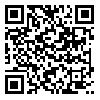Volume 18, Issue 1 (3-2024)
payavard 2024, 18(1): 1-9 |
Back to browse issues page
Ethics code: IR.IUMS.REC1401.164.
Download citation:
BibTeX | RIS | EndNote | Medlars | ProCite | Reference Manager | RefWorks
Send citation to:



BibTeX | RIS | EndNote | Medlars | ProCite | Reference Manager | RefWorks
Send citation to:
Moradimajd P, Sedighmaroufi S, Taghizadeh S, Abolghasemi J, Babajani A. Study of Compliance with the Guidelines for Registration and Labeling of Anesthesia Drugs in the Operating Room. payavard 2024; 18 (1) :1-9
URL: http://payavard.tums.ac.ir/article-1-7534-en.html
URL: http://payavard.tums.ac.ir/article-1-7534-en.html
Parisa Moradimajd1 
 , Shahnam Sedighmaroufi2
, Shahnam Sedighmaroufi2 
 , Shaqayeq Taghizadeh *
, Shaqayeq Taghizadeh * 
 3, Jamileh Abolghasemi4
3, Jamileh Abolghasemi4 
 , Alireza Babajani5
, Alireza Babajani5 


 , Shahnam Sedighmaroufi2
, Shahnam Sedighmaroufi2 
 , Shaqayeq Taghizadeh *
, Shaqayeq Taghizadeh * 
 3, Jamileh Abolghasemi4
3, Jamileh Abolghasemi4 
 , Alireza Babajani5
, Alireza Babajani5 

1- Assistant Professor, Department of Anesthesia, School of Paramedicine, Iran University of Medical Sciences, Tehran, Iran
2- Associate Professor, Department of Biostatistics, School of Public Health, Iran University of Medical Sciences, Tehran, Iran
3- Instructor, Department of Anesthesia, School of Paramedical Sciences, Guilan University of Medical Sciences, Rasht, Iran ,sh.taghizadeh@gums.ac.ir
4- Associate Professor, Department of Anesthesia, School of Paramedicine, Iran University of Medical Sciences, Tehran, Iran
5- Master of Science in Anesthesia Education, School of Paramedicine, Iran University of Medical Sciences, Tehran, Iran
2- Associate Professor, Department of Biostatistics, School of Public Health, Iran University of Medical Sciences, Tehran, Iran
3- Instructor, Department of Anesthesia, School of Paramedical Sciences, Guilan University of Medical Sciences, Rasht, Iran ,
4- Associate Professor, Department of Anesthesia, School of Paramedicine, Iran University of Medical Sciences, Tehran, Iran
5- Master of Science in Anesthesia Education, School of Paramedicine, Iran University of Medical Sciences, Tehran, Iran
Abstract: (842 Views)
Background and Aim: One of the basic principles in the safety of drug therapy for patients is the correct registration and labeling of anesthetic drugs, which can lead to the reduction of drug errors, the increase of drug and patient safety, the reduction of drug consumption and the environment, and the optimization of hospital costs.
Materials and Methods: This descriptive-analytical and cross-sectional research was conducted in February 2022 in the operating rooms of Iran University of Medical Sciences hospitals. The participants included 177 Anesthesia experts working in the hospitals’ operating rooms, who were included in the study by census method. The data was collected using the checklist for evaluating anesthetic drug registration and labeling guidelines and analyzed using SPSS software and one-way ANOVA, Fisher, and Pearson correlation coefficient statistical tests. The significance level was considered P value < 0.05.
Results: The average compliance with the guidelines for registration and labeling of anesthetic drugs in all hospitals was 3.559 out of the total score of 16. The average adherence to guidelines in 8 hospitals was significantly different from each other (P < 0.001). Hazrat Ali Asghar Hospital had the highest compliance rate, averaging 10.333 out of 16. Firouzgar and Shahid Akbarabadi hospitals were in the next rank, averaging 10.11 and 6.65, respectively. There was a negative and significant correlation between the level of compliance with the guidelines and the average work experience and age of the experts (P=0/17); However, gender did not significantly correlate with the degree of adherence to the guidelines(P=0/596).
Conclusion: According to the obtained results, compliance with the guidelines for registration and labeling of anesthetic drugs in most hospitals was assessed as weak and at an unfavorable level. Considering the importance of this issue in reducing medication errors and increasing patient safety, it is necessary to use empowerment and retraining courses for Anesthesia experts according to the latest guidelines.
Materials and Methods: This descriptive-analytical and cross-sectional research was conducted in February 2022 in the operating rooms of Iran University of Medical Sciences hospitals. The participants included 177 Anesthesia experts working in the hospitals’ operating rooms, who were included in the study by census method. The data was collected using the checklist for evaluating anesthetic drug registration and labeling guidelines and analyzed using SPSS software and one-way ANOVA, Fisher, and Pearson correlation coefficient statistical tests. The significance level was considered P value < 0.05.
Results: The average compliance with the guidelines for registration and labeling of anesthetic drugs in all hospitals was 3.559 out of the total score of 16. The average adherence to guidelines in 8 hospitals was significantly different from each other (P < 0.001). Hazrat Ali Asghar Hospital had the highest compliance rate, averaging 10.333 out of 16. Firouzgar and Shahid Akbarabadi hospitals were in the next rank, averaging 10.11 and 6.65, respectively. There was a negative and significant correlation between the level of compliance with the guidelines and the average work experience and age of the experts (P=0/17); However, gender did not significantly correlate with the degree of adherence to the guidelines(P=0/596).
Conclusion: According to the obtained results, compliance with the guidelines for registration and labeling of anesthetic drugs in most hospitals was assessed as weak and at an unfavorable level. Considering the importance of this issue in reducing medication errors and increasing patient safety, it is necessary to use empowerment and retraining courses for Anesthesia experts according to the latest guidelines.
Send email to the article author
| Rights and permissions | |
 |
This work is licensed under a Creative Commons Attribution-NonCommercial 4.0 International License. |



